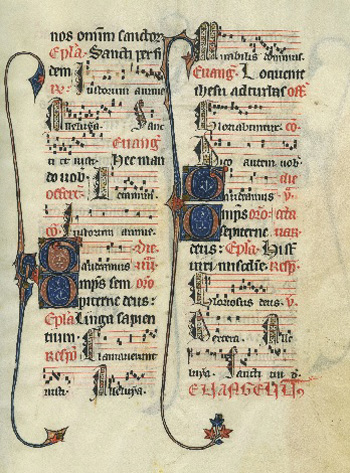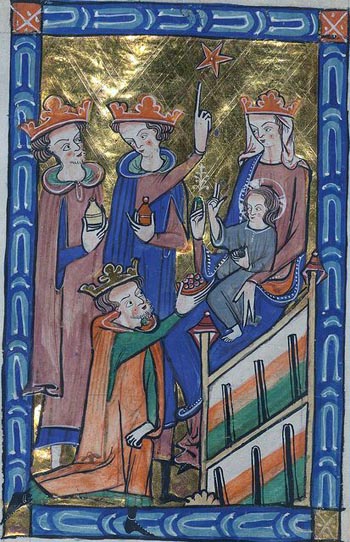Traditionalist Issues
 |
 |
 |
 |
 |
 |
 |
Dialogue Mass - LXXII
Abolishing 15 out of 18 Octaves of Feasts
If Vigils were treated badly under Pius XII, Octaves fared even worse. In fact, they were specifically mentioned as one of the first items targeted by the 1948 Commission for excision from the liturgy in the interests of “simplification.” (1)
 Of the 18 Octaves in use in the Tridentine Missal, (2) only 3 – those of Christmas, Easter and Pentecost – survived the 1956 reform. The Feasts deprived of their Octaves were:
Of the 18 Octaves in use in the Tridentine Missal, (2) only 3 – those of Christmas, Easter and Pentecost – survived the 1956 reform. The Feasts deprived of their Octaves were:
What reason, then, did Pius XII’s Commission give for the demolition of so many pillars of the lex orandi whose removal would make the whole structure of the Liturgical Year unsafe and unstable?
The official reason was the old chestnut of “simplification,” to prevent Octaves from overlapping other Feasts. But the Church already had tried and tested methods for dealing with this eventuality, which did not involve abolishing Octaves. (3)
The real reason, expressed by the Commission members in their “Memo,” was to have the Liturgy “freed from certain accretions, which obscure its beauty and diminish in a certain sense its efficacy.” (4) That was one way of saying that the growth of Octaves was a useless and unwanted addition and an ugly excrescence on the face of the Roman Rite.
Destruction of the Octave of the Epiphany
What was so unacceptable about the Octave of the Epiphany (which was even older than that of Christmas) that it had to be expunged from the Church’s Calendar in 1956? The answer was not readily apparent to contemporary Catholics, who were understandably mystified by its loss.
However, if we look ahead to the 1969 reforms, we can see with hindsight what was missing from the Epiphany Mass of the Novus Ordo but had been included in the traditional Feast and Octave. One major omission was the constantly reiterated references to the homage due to the King of Kings by “all the kings of the earth” (5) in the traditional Epiphany Mass and its Octave prayers.
This theme of the extension of Christ’s Kingship to the whole world could hardly be allowed to survive in the age of Religious Liberty ushered in by Vatican II. The Octave had to disappear so that its message would not to clash with Bugnini’s “recycled” Epiphany Mass, which would be specially written in 1969 to reflect the new progressivist outlook.
Effects of the reform
The abolition of the Octave of the Epiphany (which, incidentally, before the 1956 reforms, had outranked that of Christmas), (6) was not without repercussions. It gave rise to two innovations in the 1962 Missal, albeit tentative ones, but which would reach their full flowering in the Novus Ordo.
 First, the final day of the Octave, 13th January, was renamed by Pius XII the “Commemoration of the Baptism of the Lord.” This was a pure innovation – there had never been a precedent for such a Feast Day in the Roman Rite. (7) Nor was there a longstanding popular devotion to this aspect of Christ’s Divinity (as there had been, for example, to the Sacred Heart) (8) to justify this addition.
First, the final day of the Octave, 13th January, was renamed by Pius XII the “Commemoration of the Baptism of the Lord.” This was a pure innovation – there had never been a precedent for such a Feast Day in the Roman Rite. (7) Nor was there a longstanding popular devotion to this aspect of Christ’s Divinity (as there had been, for example, to the Sacred Heart) (8) to justify this addition.
In the Tridentine Missal, the Baptism of Christ in the Jordan was only narrated in the Gospel of the day as a second Manifestation of His Divinity, so as not to detract from the pre-eminence of the first Epiphany, which was being celebrated in the Octave.
The significance of this innovation was lost on most Catholics before Vatican II because they could not have realized where it was leading. For, at that time, only the members of the Liturgical Commission and their close associates knew the answer, and they were keeping it a secret.
But, the crunch was yet to come. It transpired that Pius XII’s initiative was a kite-flying exercise to prepare the faithful for the next stage of the reform. Having made the faithful swallow the new title, the reformers invented and served up a new Feast to correspond – the Baptism of the Lord – which entered the Roman Calendar in 1969.
The long-term effect of this reform was to undermine the immemorial custom in the West of thinking of the Epiphany specifically as the Feast of Christ’s Manifestation to the Gentiles in the persons of the Magi. (9) Nevertheless, it was incorporated into the 1962 Missal by Pope John XXIII.
 Only with hindsight can we see the connection between Pius XII’s reform and that of Paul VI who extended the Christmas Season to the first Sunday after the Epiphany (the newly minted Baptism of the Lord). By conflating the two Manifestations of Christ (His Birth and Baptism), the reformers obscured the defining characteristic of the Epiphany – Christ manifesting himself to all people as their Divine King, to Whom all rulers owe subservience – a doctrine utterly abhorrent to the progressivist mindset.
Only with hindsight can we see the connection between Pius XII’s reform and that of Paul VI who extended the Christmas Season to the first Sunday after the Epiphany (the newly minted Baptism of the Lord). By conflating the two Manifestations of Christ (His Birth and Baptism), the reformers obscured the defining characteristic of the Epiphany – Christ manifesting himself to all people as their Divine King, to Whom all rulers owe subservience – a doctrine utterly abhorrent to the progressivist mindset.
Even a small child can grasp that notion when looking at the crib figures with the Three Kings bowing down to the Christ Child. Now, as a result of the Novus Ordo, most adults know less about the Faith than the children of previous generations.
Second, in 1956, the period of the Liturgical Year after 13th January (Pius XII’s “Commemoration of the Baptism of the Lord”) was renamed “the time per annum before Septuagesima.” Few people at the time would have spotted this time-bomb planted in the 1962 Missal, set to detonate in 1969, or even suspected that this innocuous-sounding change in nomenclature spelt doom for the traditional arrangement of seasons and feasts in the General Roman Calendar. (10)
For, the term “time per annum” was later adopted in the Novus Ordo to designate the revolutionary concept of “Ordinary Time,” invented solely to obliterate the “Sundays after the Epiphany,” the “Sundays after Pentecost” and the whole Septuagesima Season. And, sure enough, all were blown sky-high when the bomb went off.
Continued


From the Vigil Mass, Day 3, in the Octave of the Feast of SS. Peter and Paul
- Epiphany;
- Nativity of St John the Baptist;
- SS. Peter & Paul;
- St. Lawrence
- Assumption of the Blessed Virgin Mary;
- Nativity of Our Lady;
- All Saints;
- Immaculate Conception;
- St. Stephen;
- St. John the Evangelist;
- Holy Innocents;
- Solemnity of St Joseph;
- Ascension;
- Corpus Christi;
- Sacred Heart.
What reason, then, did Pius XII’s Commission give for the demolition of so many pillars of the lex orandi whose removal would make the whole structure of the Liturgical Year unsafe and unstable?
The official reason was the old chestnut of “simplification,” to prevent Octaves from overlapping other Feasts. But the Church already had tried and tested methods for dealing with this eventuality, which did not involve abolishing Octaves. (3)
The real reason, expressed by the Commission members in their “Memo,” was to have the Liturgy “freed from certain accretions, which obscure its beauty and diminish in a certain sense its efficacy.” (4) That was one way of saying that the growth of Octaves was a useless and unwanted addition and an ugly excrescence on the face of the Roman Rite.
Destruction of the Octave of the Epiphany
What was so unacceptable about the Octave of the Epiphany (which was even older than that of Christmas) that it had to be expunged from the Church’s Calendar in 1956? The answer was not readily apparent to contemporary Catholics, who were understandably mystified by its loss.
However, if we look ahead to the 1969 reforms, we can see with hindsight what was missing from the Epiphany Mass of the Novus Ordo but had been included in the traditional Feast and Octave. One major omission was the constantly reiterated references to the homage due to the King of Kings by “all the kings of the earth” (5) in the traditional Epiphany Mass and its Octave prayers.
This theme of the extension of Christ’s Kingship to the whole world could hardly be allowed to survive in the age of Religious Liberty ushered in by Vatican II. The Octave had to disappear so that its message would not to clash with Bugnini’s “recycled” Epiphany Mass, which would be specially written in 1969 to reflect the new progressivist outlook.
Effects of the reform
The abolition of the Octave of the Epiphany (which, incidentally, before the 1956 reforms, had outranked that of Christmas), (6) was not without repercussions. It gave rise to two innovations in the 1962 Missal, albeit tentative ones, but which would reach their full flowering in the Novus Ordo.

The manifestation of Christ to the Gentiles was undermined by eliminating the Epiphany Octave
In the Tridentine Missal, the Baptism of Christ in the Jordan was only narrated in the Gospel of the day as a second Manifestation of His Divinity, so as not to detract from the pre-eminence of the first Epiphany, which was being celebrated in the Octave.
The significance of this innovation was lost on most Catholics before Vatican II because they could not have realized where it was leading. For, at that time, only the members of the Liturgical Commission and their close associates knew the answer, and they were keeping it a secret.
But, the crunch was yet to come. It transpired that Pius XII’s initiative was a kite-flying exercise to prepare the faithful for the next stage of the reform. Having made the faithful swallow the new title, the reformers invented and served up a new Feast to correspond – the Baptism of the Lord – which entered the Roman Calendar in 1969.
The long-term effect of this reform was to undermine the immemorial custom in the West of thinking of the Epiphany specifically as the Feast of Christ’s Manifestation to the Gentiles in the persons of the Magi. (9) Nevertheless, it was incorporated into the 1962 Missal by Pope John XXIII.

Hollywood-inspired images for the new Baptism of Christ feast in the 1st Sunday after January 6
Even a small child can grasp that notion when looking at the crib figures with the Three Kings bowing down to the Christ Child. Now, as a result of the Novus Ordo, most adults know less about the Faith than the children of previous generations.
Second, in 1956, the period of the Liturgical Year after 13th January (Pius XII’s “Commemoration of the Baptism of the Lord”) was renamed “the time per annum before Septuagesima.” Few people at the time would have spotted this time-bomb planted in the 1962 Missal, set to detonate in 1969, or even suspected that this innocuous-sounding change in nomenclature spelt doom for the traditional arrangement of seasons and feasts in the General Roman Calendar. (10)
For, the term “time per annum” was later adopted in the Novus Ordo to designate the revolutionary concept of “Ordinary Time,” invented solely to obliterate the “Sundays after the Epiphany,” the “Sundays after Pentecost” and the whole Septuagesima Season. And, sure enough, all were blown sky-high when the bomb went off.
Continued
- 1948 Memoria, chap. 1, n. 5.
- This number does not include the Octaves for local Feasts such as the dedication of a church or cathedral, for the titular of a church, or for the Patron Saint of a religious order, diocese or nation, all of which were abolished by Pius XII.
- The rubrics of the Missal dealt successfully with the problem of “occurrence” (i.e., when two Feasts coincided) in a variety of ways, including commemorating the lower-ranking Feast in the Mass of the day, translating it to the next free day, inserting it into a Local Calendar or celebrating it at a different altar from that of the main Mass.
- 1948 Memoria, n. 7.
- This reference, taken from Psalm 71:10-11, has also been entirely removed from the Novus Ordo Epiphany Mass.
- In the General Roman Calendar of 1954, the two Octaves were classified respectively as of second and third rank.
- Any objections to the reform were brushed aside on the irrelevant grounds that the Baptism of Christ was celebrated by Eastern Rite Christians on the Epiphany.
- Although the Octave of the Sacred Heart had only been added in 1929, this was not an innovation, but an enhancement of the Feast promoted by successive Popes since its institution in 1765. In fact, the cult of the Sacred Heart long pre-dates that year. As Dom Guéranger observed, there was a custom dating from the early Doctors of the Church and many Saints of regarding the Wound of Jesus’s Side pierced by the lance as “the source of all graces.”
Moreover, to atone for the sins of nations, which had violated the rights of Christ in the public sphere, Pius XI ordered that, on the Feast of the Sacred Heart, an Act of Reparation should be made in all the churches of the world. - The other two Manifestations of Christ – the Baptism of Christ and the Marriage at Cana – were mentioned in the Gospels of the 13th January and the Second Sunday after the Epiphany respectively. They reflected the themes of illumination (Baptism) and power (to work miracles) contained in the Epiphany Feast.
- The 1962 Saint Andrew Daily Missal, for example, provides an explanatory note in order to familiarize its readers with the concept of “time per annum.” With reference to the Sundays after the Epiphany and Pentecost, it states that “instead of being arranged to portray the progressivist development of the mysteries of Christ, the prayer and teaching of the Church are given for their own sake, independently of any feast or particular occasion.”

Posted June 25, 2018
______________________
______________________
 Volume I |
 Volume II |
 Volume III |
 Volume IV |
 Volume V |
 Volume VI |
 Volume VII |
 Volume VIII |
 Volume IX |
 Volume X |
 Volume XI |
 Special Edition |


